Da Jian Zhong Tang
Chinese: 大建中汤
Pinyin: Dà Jiàn Zhōng Tāng
Other names: Major Construct the Middle Decoction




Da Jian Zhong Tang
Chinese: 大建中汤
Pinyin: Dà Jiàn Zhōng Tāng
Other names: Major Construct the Middle Decoction
Ingredients: 4 herbs
Category: Formulas that warm the middle and dispel Cold
- Warms and tonifies Middle Burner Deficiency
- Directs rebellious Qi downward
- Relieves pain
Contraindications: contraindicated in cases with internal clumping, Damp-Heat, or Yin and Blood... contraindicated in cases with internal clumping, Damp-Heat, or Yin and Blood Deficiency due to the formula's warming and drying actions. see more
Source: Essentials from the Golden Cabinet (220 AD)
The information provided here is not a replacement for a doctor. You shouldn't use it for the purpose of self-diagnosing or self-medicating but rather so you can have a more informed discussion with a professional TCM practitioner.
Da Jian Zhong Tang is a 4-ingredient Chinese Medicine formula with Sichuan Pepper (Hua Jiao) as a principal ingredient.
Invented in 220 AD, it belongs to the category of formulas that warm the middle and dispel Cold. Its main actions are: 1) warms and tonifies Middle Burner Deficiency and 2) directs rebellious Qi downward.
In Chinese Medicine health conditions are thought to arise due to "disharmonies" in the body as a system. These disharmonies are called "patterns" and the very purpose of herbal formulas is to fight them in order to restore the body's harmony.
In this case Da Jian Zhong Tang is used by TCM practitioners to fight patterns like Empty-Cold. From a Western Medicine standpoint, such patterns can give rise to a range of conditions such as chronic gastritis, gastric ulcer or duodenal ulcer for instance.
On this page, after a detailed description of each of the four ingredients in Da Jian Zhong Tang, we review the patterns and conditions that Da Jian Zhong Tang helps treat.
The four ingredients in Da Jian Zhong Tang

Hua Jiao is a king ingredient in Da Jian Zhong Tang. Like the name indicates, it means it has more power than other ingredients in the formula.
1. Sichuan Pepper (Hua Jiao)
Part used: Dried pericarp of ripe fruit
Nature: Warm
Taste(s): Pungent
Hua Jiao stimulates the Middle Burner Yang and dispels
Coldness so as to relive pain. It also warms the
gate of vitality (Ming Meng), so that the Yang is mobilized from its origin all the way up to the Upper Burner.

Gan Jiang is a deputy ingredient in Da Jian Zhong Tang. This means it helps the king ingredient(s) treat the main pattern or it serves to treat a coexisting pattern.
2. Dried Ginger (Gan Jiang)
Gan Jiang supports the key herbs in warming the Middle Burner. It also prevents the Cold Stomach Qi going upwards so as to ease vomiting.

Ren Shen is an assistant ingredient in Da Jian Zhong Tang. This means that it either serves to reinforces the effect of other ingredients or it moderates their toxicity.
3. Ginseng (Ren Shen)
Part used: Dried root
Nature: Warm
Meridian affinity: HeartLungSpleen
Category: Tonic herbs for Qi Deficiency
In general Ren Shen's main actions are as follows: "Very strongly tonifies the Qi. Tonifies the Lungs and Spleen. Assists the body in the secretion of Fluids and stops thirst. Strengthens the Heart and calms the Shen (mind/spirit)."
In the context of Da Jian Zhong Tang, it is used because it tonifies and strengthen the Middle Burner Qi so as to relieve the abdominal pain.

Yi Tang is an assistant ingredient in Da Jian Zhong Tang. This means that it either serves to reinforces the effect of other ingredients or it moderates their toxicity.
4. Maltose (Yi Tang)
Part used: The sugar
Nature: Warm
Taste(s): Sweet
Meridian affinity: SpleenStomachLung
Category: Tonic herbs for Qi Deficiency
Yi Tang tonifies and strengthens the Middle Burner Qi so as to relieve the abdominal pain. It also counterbalances any excessive acrid and drying actions of the key herb so as to limit the Qi injuring.
Da Jian Zhong Tang is used to treat Empty-Cold
It's important to remember that herbal formulas are meant to treat patterns, not "diseases" as understood in Western Medicine. According to Chinese Medicine patterns, which are disruptions to the body as a system, are the underlying root cause for diseases and conditions.
As such Da Jian Zhong Tang is mostly used to treat the pattern "Empty-Cold" which we describe below.
But before we delve into Empty-Cold here is an overview of the Western conditions it is commonly associated with:
Chronic gastritis Gastric ulcer Duodenal ulcer Chronic pancreatitis Chronic cholecystitis Urinary calculi Intestinal spasms
Again it wouldn't be correct to say "Da Jian Zhong Tang treats chronic gastritis" for instance. Rather, Da Jian Zhong Tang is used to treat Empty-Cold, which is sometimes the root cause behind chronic gastritis.
Now let's look at Empty-Cold, a pattern that TCM practitioners commonly treat with Da Jian Zhong Tang.

'Cold' as a body pattern in Chinese Medicine is one of the so-called "Eight Principles". Learn more about Cold pattern in Chinese Medicine
Empty-Cold
Pulse type(s): Deep (Chen), Slow (Chi), Weak (Ruo)
Symptoms: Anemia Nasitis Sweating Pale face No thirst Dizziness No period Cold limbs Weak Limbs Weak voice Leukorrhea Listlessness Loose stools Palpitations Poor appetite Painful period Scanty periods Feeling of cold Clear urination Aversion to cold Frequent urination Shortness of breath
Da Jian Zhong Tang is sometimes prescribed by TCM practitioners to treat Empty-Cold. This pattern leads to symptoms such as feeling of cold, cold limbs, pale face and no thirst. Patients with Empty-Cold typically exhibit deep (Chen), slow (Chi) or weak (Ruo) pulses.
Full-Cold is mainly caused by external Cold Evil invasion or Yin Excess, while Empty-Cold is largely due to Deficient Yang or Qi, which fails to warm the body. Therefore the patients have cold limbs, feel cold and dislike cold.
Both pattern has Cold manifestations, but the Empty type is more for... read more about Empty-Cold
Formulas similar to Da Jian Zhong Tang
Li Zhong Wan is 50% similar to Da Jian Zhong Tang
Wen Pi Tang is 40% similar to Da Jian Zhong Tang
Gui Zhi Ren Shen Tang is 40% similar to Da Jian Zhong Tang
Gu Ben Zhi Beng Tang is 33% similar to Da Jian Zhong Tang
Wu Mei Wan is 30% similar to Da Jian Zhong Tang
Ban Xia Xie Xin Tang is 29% similar to Da Jian Zhong Tang













